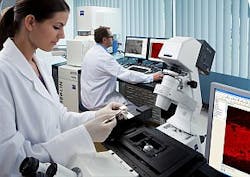Carl Zeiss correlative light and electron microscopy solution for life sciences
The Shuttle & Find hardware/software interface from Carl Zeiss (Oberkochen, Germany) connects light and scanning electron microscopes for correlative microscopy, enabling users to recall regions of interest in fixed specimens in an electron microscope in a few seconds. The Shuttle & Find correlative light and electron microscopy (CLEM) solution offers a transferable specimen holder that enables smooth specimen transfer between the light and electron microscopes (Shuttle) and a software module that controls all functions of light and electron microscopes needed to identify and recall the defined region of interest (Find).
-----
PRESS RELEASE
Carl Zeiss Introduces Correlative Light and Electron Microscopy Solution for Life Sciences
Integrated hardware/software interface enables productive workflow between light and electron microscopes for the first time
JENA/OBERKOCHEN, Germany & PEABODY, Mass.--(BUSINESS WIRE)-- Carl Zeiss today introduced a unique hardware/software interface to connect light and scanning electron microscopes for correlative microscopy in the life sciences. The “Shuttle & Find” interface enables users to recall regions of interest in fixed specimens in an electron microscope, which were previously identified in a light microscope and vice versa. The entire process takes only a few seconds. This opens up totally new dimensions in microscopy: rapid and precise overlay of light and electron microscope images, high-resolution magnification of the details, and the merger of functional and structural information.
The key elements of Shuttle & Find for correlative light and electron microscopy (CLEM) are:
a transferable specimen holder that enables smooth specimen transfer between the light and electron microscopes (Shuttle) and
a software module that controls all functions of light and electron microscopes needed to identify and recall the defined region of interest (Find)
Dr. Ulrich Simon, president and CEO of Carl Zeiss MicroImaging GmbH said: “After the successful launch of Shuttle & Find for materials analysis, we are taking the next step and providing scientists in life science disciplines with a productive solution for correlative microscopy. As the world’s only provider of both light and electron microscopes in all performance classes, Carl Zeiss is uniquely well suited to bridge the micro and nano worlds.”
Applications background
In the life sciences, the relationship between structure and function is increasingly becoming a focal point of interest. Correlative examinations that combine fluorescence microscope images and scanning electron microscope images of one and the same region open up new and fascinating possibilities. One of the scientific partners in the development of the interface is Dr. Roger Wepf, director of the EMEZ Electron Microscope Center at the ETH in Zurich. In his words, “Very helpful indeed. Shuttle & Find eliminates the time-consuming search for identical regions in the light and electron microscopes. Correlative microscopy now really works even if there are still some issues regarding specimen preparation.”
Shuttle & Find connects all light microscopes from Carl Zeiss that can be equipped with a motorized stage (SteREO Discovery, Axio Scope, Axio Imager, Axio Examiner and also the Axio Observer inverted microscope) with all ZEISS scanning electron microscopes of the types EVO, SIGMA, SUPRA, ULTRA, MERLIN as well as with the CrossBeam (FIB-SEM) system AURIGA.
For more information about Shuttle & Find, please visit the Carl Zeiss booth at the IMC 17 in Rio de Janeiro, Brazil, contact your local sales representative or go to www.zeiss.de/corrmic.
